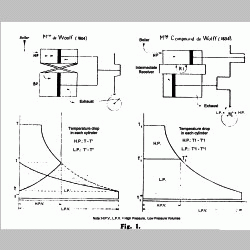 |
Click to enlarge |
First, one have to remember that in those times not any smart system existed to distribute the steam in the cylinder(s), an adjustable valve gear and distribution system was to invent and create.
In those times the method was then to open the steam inlet during all the travel of the piston by using to the arrangement that one says to have been created by a lazy worker of James Watt, Humphrey Potter, tired to have to open and close by hand the inlet and exhaust valves following the position of the piston giving thus the required automaticity to the steam machine. This last point (the "invention" of H. Potter) could be an early example of urban legend according to some sources but there is no concensus about that.
The dual or compound expansion has been invented and introduced by Jonathan Hornblower, builder of machines in the city of Newcomen in 1781 (patent of july the 13).
The idea seemed bright as it allowed by sending the steam exhausted by the first cylinder in a second one having twice the capacity of the first to expand the steam by a factor of two, which allowed to twice the energy delivered by one volume of steam supplied by the boiler.
Arthur Woolf reworked on Hornblower's idea with much more success thanks to the raise in the pressures used that occured meanwhile, allowing him to raise the expansion to 8 times.
In Hornblower's and Woolf's machines the two cylinders were located side by side and drove the same crank.
In 1834 Ernest Wolff took a patent (#6000) describing the compound machine featuring an intermediate receiver between the high pressure and low pressure cylinder(s) whose pistons drove staggered cranks as it was later used on the locomotives. The direct injection of steam from the boiler into the intermediate receiver to help starting was also planned in the patent.
On the same basis were developped triple and even quadruple expansion engines which were widely used on Ships and in the industry but the railways remained definitely and firmly opposed to their use, so becoming "... The most backward users of steam machines!" according to the famous Anatole Mallet.
Copyright © 1997 - 2013 by T. Stora. All rights reserved. Reproduction, translation, total or partial on any media absolutely forbidden without preliminary permission and agreement.